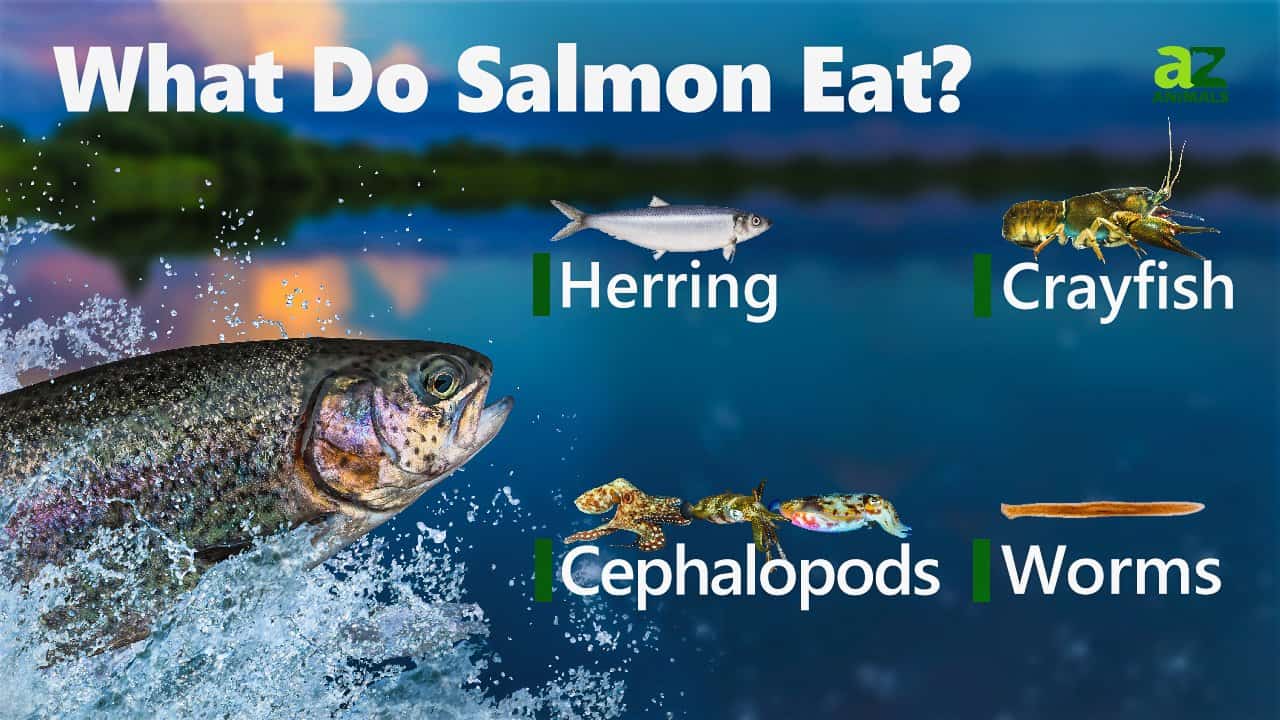Salmon are amazing fish that inhabit both freshwater and saltwater environments during their lifecycle Their diverse diets allow them to thrive in these varied habitats But have you ever wondered – what exactly do salmon eat in the wild? Let’s find out!
Salmon Fry And Fingerlings
After hatching from eggs, baby salmon are called fry. At this stage, they stay in freshwater streams and lakes, living off their yolk sacs. Once the yolk is absorbed, the fry start actively feeding. They are now called fingerlings.
Fingerlings eat a variety of small organisms found in freshwater These include
- Insect larvae – Mayflies, stoneflies, caddisflies
- Crustaceans – Scuds, amphipods, copepods
- Aquatic insects – Midges, beetles, true flies
- Small fish – Minnows, sticklebacks
- Fish eggs
- Algae
- Terrestrial insects that fall into the water
Salmon fry are voracious eaters. They feed throughout the day, darting around in search of prey. Their diet provides protein and nutrients needed for rapid growth.
Juvenile Salmon
Once fingerlings grow bigger, they are called juvenile salmon or parr. They continue living in freshwater streams and lakes for 1-3 years before migrating to the ocean.
Juveniles eat similar foods as fingerlings but also consume larger prey as they grow. Their diet includes:
- Bigger crustaceans – Crayfish, shrimps
- Larger aquatic insects – Dragonfly and damselfly nymphs
- Small fish – Minnows, sculpins, sticklebacks
- Fish eggs and fry
- Terrestrial insects – Grasshoppers, beetles, ants
- Worms
- Algae
Salmon parr have specialized teeth called denticles on their tongues to grip slippery prey. They aggressively defend their feeding territories against competitors.
Adult Salmon In The Ocean
When juvenile salmon undergo physiological changes to adapt to saltwater, they are called smolts. Smolts migrate downstream to the ocean where they become adult salmon.
In the nutrient-rich Pacific Ocean, adult salmon eat a wide variety of marine prey. The most common saltwater foods are:
- Small forage fish – Herring, sandlance, anchovies
- Crustaceans – Krill, amphipods, crab larvae
- Squid
- Polychaete worms
- Pteropods – Sea snails
- Copepods
- Fish eggs and larvae
The availability of high-fat forage fish helps adult salmon build up energy reserves for their upstream spawning migration. Some salmon species like sockeye even accumulate carotenoid pigments from eating shrimp and krill, giving their flesh a distinctive red color.
Spawning Salmon
When adult salmon return to freshwater to spawn, they stop feeding altogether. They rely completely on stored energy reserves to migrate, develop mature eggs and sperm, establish redds or nests, and spawn the next generation.
Many salmon species cease feeding weeks or months before even entering freshwater. Chinook salmon may go without food for over 6 months before spawning! This fasting behavior concentrates their energy on the single goal of successful reproduction.
During their complex life cycle, salmon inhabit vastly different ecosystems and exhibit fascinating changes in feeding behavior. Fry and juveniles are active predators in freshwater, feeding on diverse small prey. Adults gorge on marine fish and invertebrates to build up energy stores for spawning. Finally, sexually mature salmon cease feeding altogether to focus solely on reproduction. Understanding salmon diets provides key insights that help conserve these incredible fish in the wild.

Where do Atlantic salmon live?
Atlantic salmon used to be found from Long Island Sound to New England, but those populations no longer exist in these rivers. Currently U.S. Atlantic salmon are only found in a handful of rivers in Maine.
What eats Atlantic salmon?
In freshwater, juveniles are eaten by a variety of fish (smallmouth bass, striped bass, Northern pike, slimy sculpin, etc.), birds (kingfisher, double-crested cormorant, mergansers, osprey, blue heron, snowy egret, etc.), and mammals (otter, mink, etc.).
In the ocean, Atlantic salmon are eaten by:
- Large predatory fish like Atlantic halibut, Atlantic bluefin tuna, swordfish, and striped bass
- Greenland shark, mako sharks, porbeagle sharks, and other sharks
- Seabirds such as the Northern gannet
- Various seals (harp, grey, harbor, etc.)
- Toothed whales like killer whales, dolphins, and porpoises
Atlantic salmon are also caught for consumption by humans in targeted aboriginal or traditional First Nations fisheries.
What Do Salmon Eat? Complete Feeding Guide And Facts
FAQ
What do salmon naturally eat?
When they’re in the ocean, young and adult salmon eat a wide variety of prey, including: Fish such as capelin, Atlantic herring, sand lance, barracudina and lanternfish. Crustaceans such as amphipods and euphausiids or “krill”
What do wild caught salmon eat?
Wild salmon primarily eat zooplankton, small crustaceans, and insects in their freshwater habitat. In the ocean, they expand their diet to include smaller fish, shrimp, squid, and even eel.
Why do salmon stop eating in freshwater?
Salmon stop eating in freshwater primarily because they are focusing all their energy on their spawning migration and reproductive processes.
What is salmon’s favorite food?
Although most adult Pacific salmon feed on small fish, shrimp, and squid, sockeye feed on plankton they filter through gill rakers.
